Government
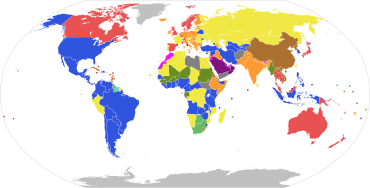
Parliamentary systems:Head of government is elected or nominated by and accountable to the legislature
Presidential system:Head of government (president) is popularly elected and independent of the legislature
Hybrid systems:
Note:this chart representsde juresystems of government, not thede factodegree of democracy.
| Part ofa serieson |
| Governance |
|---|
Agovernmentis the system or group of people governing an organized community, generally astate.
In the case of its broad associative definition, government normally consists oflegislature,executive,andjudiciary.Government is a means by which organizational policies are enforced, as well as a mechanism for determining policy. In many countries, the government has a kind ofconstitution,a statement of its governing principles and philosophy.
While all types of organizations havegovernance,the termgovernmentis often used more specifically to refer to the approximately 200independent national governmentsandsubsidiary organizations.
The main types of modernpolitical systemsrecognized aredemocracies,totalitarian regimes,and, sitting between these two,authoritarian regimeswith a variety ofhybrid regimes.[1][2]Modern classification system also includemonarchiesas a standalone entity or as a hybrid system of the main three.[3][4]Historically prevalent forms of government include monarchy,aristocracy,timocracy,oligarchy,democracy,theocracy,andtyranny.These forms are not always mutually exclusive, andmixed governmentsare common. The main aspect of any philosophy of government is how political power is obtained, with the two main forms beingelectoral contestandhereditary succession.
Definitions and etymology
A government is thesystemtogovernastateor community. TheColumbia Encyclopediadefines government as "a system of social control under which the right to make laws, and the right to enforce them, is vested in a particular group in society".[5]While all types of organizations havegovernance,the wordgovernmentis often used more specifically to refer to the approximately 200independent national governmentson Earth, as well as their subsidiary organizations, such asstate and provincial governmentsas well aslocal governments.[6]
The wordgovernmentderives from the Greek verbκυβερνάω[kubernáo] meaningto steerwith agubernaculum(rudder), the metaphorical sense being attested in the literature ofclassical antiquity,includingPlato'sShip of State.[7]InBritish English,"government" sometimes refers to what's also known as a "ministry"or an"administration",i.e., the policies and government officials of a particular executive or governingcoalition.Finally,governmentis also sometimes used in English as asynonymfor rule or governance.[8]
In other languages,cognatesmay have a narrower scope, such as thegovernment of Portugal,which is actually more similar to the concept of"administration".
History
Earliest governments
The moment and place that the phenomenon of human government developed is lost in time; however, history does record the formations of early governments. About 5,000 years ago, the first small city-states appeared.[9]By the third to second millenniums BC, some of these had developed into larger governed areas:Sumer,ancient Egypt,theIndus Valley civilization,and theYellow River civilization.[10]
One reason that explains the emergence of governments includes agriculture. Since theNeolithic Revolution,agriculture has been an efficient method to create food surplus. This enabled people to specialize in non-agricultural activities. Some of them included being able to rule over others as an external authority. Others included social experimentation with diverse governance models. Both these activities formed the basis of governments.[11]These governments gradually became more complex as agriculture supported larger and denser populations, creating newinteractionsandsocial pressuresthat the government needed to control.David Christianexplains
As farming populations gathered in larger and denser communities, interactions between different groups increased and the social pressure rose until, in a striking parallel with star formation, new structures suddenly appeared, together with a new level of complexity. Like stars, cities and states reorganize and energize the smaller objects within their gravitational field.[9]
Another explanation includes the need to properly manage infrastructure projects such as water infrastructure. Historically, this required centralized administration and complex social organisation, as seen in regions like Mesopotamia.[12]However, there is archaeological evidence that shows similar successes with more egalitarian and decentralized complex societies.[13]
Modern governments

Starting at the end of the 17th century, the prevalence of republican forms of government grew. TheEnglish Civil WarandGlorious Revolutionin England, theAmerican Revolution,and theFrench Revolutioncontributed to the growth of representative forms of government. TheSoviet Unionwas the first large country to have aCommunistgovernment.[6]Since the fall of theBerlin Wall,liberal democracyhas become an even more prevalent form of government.[14]
In the nineteenth and twentieth centuries, there was a significant increase in the size and scale of government at the national level.[15]This included the regulation of corporations and the development of thewelfare state.[14]
Political science
| Part of thePolitics series |
| Politics |
|---|
|
|
Classification
In political science, it has long been a goal to create a typology or taxonomy ofpolities,as typologies of political systems are not obvious.[16]It is especially important in thepolitical sciencefields ofcomparative politicsandinternational relations.Like all categories discerned within forms of government, the boundaries of government classifications are either fluid or ill-defined.
Superficially, all governments have an officialde jureor ideal form. The United States is a federal constitutional republic, while the formerSoviet Unionwas a federalsocialist republic.However self-identification is not objective, and as Kopstein and Lichbach argue, defining regimes can be tricky, especiallyde facto,when both its government and its economy deviate in practice.[17]For example,Voltaireargued that "theHoly Roman Empireis neither Holy, nor Roman, nor an Empire ".[18]In practice, the Soviet Union was a centralized autocratic one-party state underJoseph Stalin.
Identifying a form of government is also difficult because manypolitical systemsoriginate as socio-economic movements and are then carried into governments by parties naming themselves after those movements; all with competing political ideologies. Experience with those movements in power, and the strong ties they may have to particular forms of government, can cause them to be considered as forms of government in themselves.
Other complications include general non-consensus or deliberate "distortion or bias"of reasonable technical definitions of political ideologies and associated forms of governing, due to the nature of politics in the modern era. For example: The meaning of" conservatism "in the United States has little in common with the way the word's definition is used elsewhere. As Ribuffo notes," what Americans now call conservatism much of the world calls liberalism orneoliberalism";a" conservative "in Finland would be labeled a"socialist"in the United States.[19]Since the 1950s conservatism in the United States has been chiefly associated withright-wing politicsand theRepublican Party.However, during the era ofsegregationmanySouthern Democratswere conservatives, and they played a key role in theconservative coalitionthat controlled Congress from 1937 to 1963.[20][a]
Social-political ambiguity
Opinions vary by individuals concerning the types and properties of governments that exist. "Shades of gray" are commonplace in any government and its corresponding classification. Even the most liberal democracies limit rival political activity to one extent or another while the most tyrannical dictatorships must organize a broad base of support thereby creating difficulties for "pigeonholing"governments into narrow categories. Examples include the claims of theUnited States as being a plutocracyrather than a democracy since some American voters believe elections are being manipulated by wealthySuper PACs.[21]Some consider that government is to be reconceptualised where in times of climatic change the needs and desires of the individual are reshaped to generate sufficiency for all.[22]
Measurement of governing
The quality of a government can be measured byGovernment effectiveness index,which relates topolitical efficacyandstate capacity.[23]
Forms
| Part of thePolitics series |
| Basic forms ofgovernment |
|---|
| List of countries by system of government |
|
|
Platoin his bookThe Republic(375 BC) divided governments into five basic types (four being existing forms and one being Plato's ideal form, which exists "only in speech" ):[24]
- Aristocracy(rule bylaw and order,like ideal traditional "benevolent" kingdoms that are not tyrannical)
- Democracy(rule by purelibertyandequality,like afreecitizen)
- Oligarchy(rule by wealth and market-based-ethics, like alaissez-fairecapitalist state)
- Timocracy(rule by honor and duty, like a "benevolent" military; Sparta as an example)
- Tyranny(rule by fear,like adespot)
These five regimes progressively degenerate starting with aristocracy at the top and tyranny at the bottom.[25]
In hisPolitics,Aristotle elaborates on Plato's five regimes discussing them in relation to the government of one, of the few, and of the many.[26]From this follows the classification of forms of government according to which people have the authority to rule: either one person (anautocracy,such as monarchy), a select group of people (an aristocracy), or the people as a whole (a democracy, such as a republic).
Thomas Hobbesstated on their classification:
The difference ofCommonwealthsconsisteth in the difference of thesovereign,or the person representative of all and every one of the multitude. And because the sovereignty is either in one man, or in an assembly of more than one; and into that assembly either every man hath right to enter, or not everyone, but certain men distinguished from the rest; it is manifest there can be but three kinds of Commonwealth. For the representative must need to be one man or more; and if more, then it is the assembly of all, or but of a part. When the representative is one man, then is the Commonwealth a monarchy; when an assembly of all that will come together, then it is a democracy or popular Commonwealth; when an assembly of a part only, then it is called an aristocracy. In other kinds of Commonwealth there can be none: for either one, or more, or all, must have the sovereign power (which I have shown to be indivisible) entire.[27]
Modern basic political systems
According toYaleprofessorJuan José Linz,there a three main types ofpolitical systemstoday:democracies, totalitarian regimesand, sitting between these two,authoritarian regimeswithhybrid regimes.[2][28]Another modern classification system includesmonarchiesas a standalone entity or as a hybrid system of the main three.[3]Scholars generally refer to adictatorshipas either a form of authoritarianism or totalitarianism.[29][2][30]
Autocracy
An autocracy is a system of government in which supremepoweris concentrated in the hands of one person, whose decisions are subject to neither external legal restraints nor regularized mechanisms of popular control (except perhaps for the implicit threat of acoup d'étator massinsurrection).[31]Absolute monarchyis a historically prevalent form of autocracy, wherein amonarchgoverns as a singularsovereignwith no limitation onroyal prerogative.Most absolute monarchies arehereditary,however some, notably theHoly See,areelectedby anelectoral college(such as thecollege of cardinals,orprince-electors). Other forms of autocracy includetyranny,despotism,anddictatorship.
Aristocracy
Aristocracy[b]is a form of government that places power in the hands of a small,eliteruling class,[32]such as a hereditarynobilityorprivilegedcaste.This class exercisesminority rule,often as alandedtimocracy,wealthyplutocracy,oroligarchy.
Many monarchies were aristocracies, although, in modern constitutional monarchies, the monarch may have little effective power. The termaristocracycould also refer to the non-peasant,non-servant, and non-cityclasses in thefeudal system.[citation needed]
Democracy

- National governments which self-identify as democracies
- National governments which do not self-identify as democracies
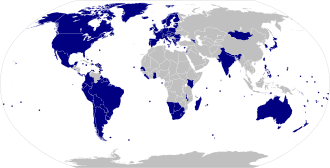
Democracy is a system of government wherecitizensexercise power byvotinganddeliberation.In adirect democracy,the citizenry as a whole directly forms aparticipatorygoverning body and vote directly on each issue. Inindirect democracy,the citizenry governs indirectly through the selection ofrepresentativesordelegatesfrom among themselves, typically byelectionor, less commonly, bysortition.These select citizens then meet to form a governing body, such as a legislature orjury.
Some governments combine both direct and indirect democratic governance, wherein the citizenry selects representatives to administer day-to-day governance, while also reserving the right to govern directly throughpopular initiatives,referendums(plebiscites), and theright of recall.In aconstitutional democracythe powers of the majority are exercised within the framework of representative democracy, but the constitution limitsmajority rule,usually through the provision by all of certainuniversal rights,such asfreedom of speechorfreedom of association.[33][34]
Republics
A republic is a form of government in which the country is considered a "public matter" (Latin:res publica), not the private concern or property of the rulers, and where offices of states are subsequently directly or indirectly elected or appointed rather than inherited. The people, or some significant portion of them, have supreme control over the government and where offices of state are elected or chosen by elected people.[35][36]
A common simplified definition of a republic is a government where the head of state is not a monarch.[37][38]Montesquieuincluded bothdemocracies,where all the people have a share in rule, andaristocraciesoroligarchies,where only some of the people rule, as republican forms of government.[39]
Other terms used to describe different republics includedemocratic republic,parliamentary republic,semi-presidential republic,presidential republic,federal republic,people's republic,andIslamic republic.
Federalism
Federalism is a political concept in which agroupof members are bound together bycovenantwith a governingrepresentative head.The term "federalism" is also used to describe a system of government in whichsovereigntyis constitutionally divided between a central governing authority and constituent political units, variously called states, provinces or otherwise. Federalism is a system based upon democratic principles and institutions in which the power to govern is shared between national and provincial/state governments, creating what is often called afederation.[40]Proponents are often calledfederalists.
Branches
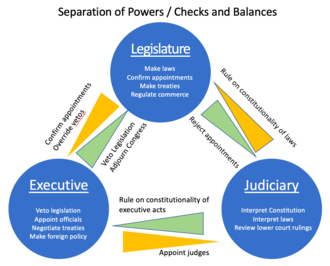
Governments are typically organised into distinct institutions constituting branches of government each with particularpowers,functions, duties, and responsibilities. The distribution of powers between these institutions differs between governments, as do the functions and number of branches. An independent, parallel distribution of powers between branches of government is theseparation of powers.A shared, intersecting, or overlapping distribution of powers is thefusion of powers.
Governments are often organised into three branches with separate powers: a legislature, an executive, and a judiciary; this is sometimes called thetrias politicamodel. However, inparliamentaryandsemi-presidential systems,branches of government often intersect, having shared membership and overlapping functions. Many governments have fewer or additional branches, such as an independentelectoral commissionorauditorybranch.[41]
Party system
| Part of thePolitics series |
| Party politics |
|---|
|
|
Presently, most governments are administered by members of an explicitly constitutedpolitical partywhich coordinates the activities of associated governmentofficialsandcandidatesfor office. In amultiparty systemof government, multiple political parties have the capacity to gain control of government offices, typically by competing inelections,although theeffective number of partiesmay be limited.
Amajority governmentis a government by one or moregoverning partiestogether holding an absolute majority of seats in the parliament, in contrast to aminority governmentin which they have only a plurality of seats and often depend on aconfidence-and-supplyarrangement with other parties. Acoalition governmentis one in which multiple parties cooperate to form a government as part of acoalition agreement.In a single-party government, a single party forms a government without the support of a coalition, as is typically the case with majority governments,[42][43]but even a minority government may consist of just one party unable to find a willing coalition partner at the moment.[44]
A state that continuously maintains a single-party government within a (nominally) multiparty system possesses adominant-party system.In a (nondemocratic)one-party systema singleruling partyhas the (more-or-less) exclusive right to form the government, and the formation of other parties may be obstructed or illegal. In some cases, a government may have anon-partisan system,as is the case withabsolute monarchyornon-partisan democracy.
Maps
Democracy is the most popular form of government with more than half of the nations in the world being democracies-97 of 167 nations as of 2021.[45]However the world is becoming more authoritarian with a quarter of the world's population underdemocratically backslidinggovernments.[45]
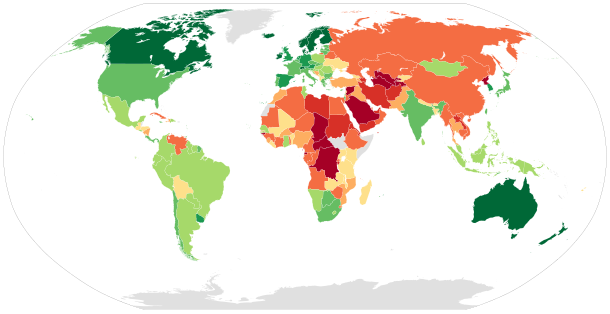
| Full Democracies 9–10 8–9 | Flawed Democracies 7–8 6–7 | Hybrid Regimes 5–6 4–5 | Authoritarian Regimes 3–4 2–3 0–2 |

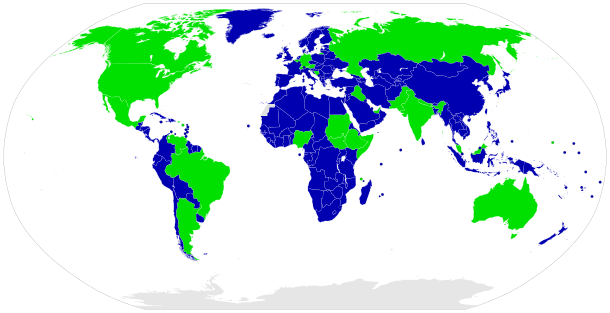
See also
- List of forms of government
- Central government
- Civics
- Comparative government
- Constitutional economics
- Deep state
- Digital democracy
- E-Government
- History of politics
- Legal rights
- List of countries by system of government
- List of European Union member states by political system
- Local government
- Ministry
- Political economy
- Political history
- Prime ministerial government
- State (polity)
- Voting system
- World government
Notes
- ^Frederickson 2000,p. 12, quote: "...conservative southern Democrats viewed warily the potential of New Deal programs to threaten the region's economic dependence on cheap labor while stirring the democratic ambitions of the disfranchised and undermining white supremacy."
- ^Ancient Greek:ἀριστοκρατίαaristokratía,fromἄριστοςaristos"excellent", andκράτοςkratos"power".
- ^Conducted by Americanthink tankFreedom House,which is largely funded by theUS government.
References
- ^Dobratz, B.A. (2015).Power, Politics, and Society: An Introduction to Political Sociology.Taylor & Francis. p. 47.ISBN978-1-317-34529-9.Archivedfrom the original on 30 April 2023.Retrieved30 April2023.
- ^abcLinz, Juan José(2000).Totalitarian and Authoritarian Regimes.Lynne Rienner Publisher. p. 143.ISBN978-1-55587-890-0.OCLC1172052725.Archivedfrom the original on 22 April 2023.Retrieved20 October2022.
- ^abGarcia-Alexander, Ginny; Woo, Hyeyoung; Carlson, Matthew J. (2017).Social Foundations of Behavior for the Health Sciences.Springer. pp. 137–.ISBN978-3-319-64950-4.OCLC1013825392.
- ^"14.2 Types of Political Systems".8 April 2016. Archived fromthe originalon 22 October 2022.Retrieved20 October2022.
- ^Columbia Encyclopedia(6th ed.). Columbia University Press. 2000.[full citation needed]
- ^abSmelser & Baltes 2001,p.[page needed].
- ^Brock 2013,p. 53–62.
- ^"Government English Definition and Meaning".Lexico.Archived fromthe originalon 17 July 2022.Retrieved17 July2022.
- ^abChristian 2004,p. 245.
- ^Christian 2004,p. 294.
- ^Eagly, Alice H.; Wood, Wendy (June 1999)."The Origins of Sex Differences in Human Behavior: Evolved Dispositions Versus Social Roles".American Psychologist.54(6): 408–423.doi:10.1037/0003-066x.54.6.408.Archived fromthe originalon 17 August 2000.
- ^Fukuyama, Francis (27 March 2012).The Origins of Political Order: From Prehuman Times to the French Revolution.Farrar, Straus and Giroux. p. 70.ISBN978-0-374-53322-9.
- ^Roosevelt, Anna C. (1999)."The Maritime, Highland, Forest Dynamic and the Origins of Complex Culture".In Salomon, Frank; Schwartz, Stuart B. (eds.).Cambridge history of the Native peoples of the Americas: South America, Volume 3.Cambridge University Press. pp. 266–267.ISBN978-0-521-63075-7.Archivedfrom the original on 24 June 2016.
- ^abKuper & Kuper 2008,p.[page needed].
- ^Haider-Markel 2014,p.[page needed].
- ^Lewellen 2003,p.[page needed].
- ^Kopstein & Lichbach 2005,p. 4.
- ^Renna 2015.
- ^Ribuffo 2011,pp. 2–6, quote on p. 6.
- ^Frederickson 2000,p. 12.
- ^Freeland 2012.
- ^"Governing the "Enough" in a Warming World The Discourse of "Sufficiency" from a Climate Governmentality Perspective".Deflorian, Michel (2015). Retrieved 2 October 2023
- ^Guisan, Maria-Carmen (2009)."Government effectiveness, education, economic development and well-being: analysis of European countries in comparison with the United States and Canada, 2000-2007"(PDF).Applied Econometrics and International Development.9(1): 1.Retrieved25 April2019.
- ^Abjorensen, Norman (2019).Historical Dictionary of Democracy.Rowman & Littlefield.pp. 288–.ISBN978-1-5381-2074-3.OCLC1081354236.
- ^Brill 2016.
- ^Jordović, Ivan (2019).Taming Politics: Plato and the Democratic Roots of Tyrannical Man.Franz Steiner Verlag. p. intro.ISBN978-3-515-12457-7.OCLC1107421360.
- ^Hobbes, Thomas.– viaWikisource.
- ^Jonathan Michie, ed. (3 February 2014).Reader's Guide to the Social Sciences.Routledge. p. 95.ISBN978-1-135-93226-8.Archivedfrom the original on 22 April 2023.Retrieved20 October2022.
- ^Todd, Allan; Waller, Sally (10 September 2015). Todd, Allan; Waller, Sally (eds.).History for the IB Diploma Paper 2 AuthoritariaAuthoritarian States (20th Century).Cambridge University Press. pp. 10–.ISBN978-1-107-55889-2.Archivedfrom the original on 22 April 2023.Retrieved20 October2022.
- ^Sondrol, P. C. (2009)."Totalitarian and Authoritarian Dictators: A Comparison of Fidel Castro and Alfredo Stroessner".Journal of Latin American Studies.23(3): 599–620.doi:10.1017/S0022216X00015868.ISSN0022-216X.JSTOR157386.S2CID144333167.Archivedfrom the original on 8 March 2023.Retrieved20 October2022.
- ^Johnson, Paul M."Autocracy: A Glossary of Political Economy Terms".Auburn.edu.Archivedfrom the original on 26 December 2018.Retrieved14 September2012.
- ^"aristocracy".Oxford English Dictionary(Online ed.).Oxford University Press.(Subscription orparticipating institution membershiprequired.)
- ^Oxford English Dictionary:"democracy".
- ^Watkins, Frederick (1970). "Democracy".Encyclopædia Britannica.Vol. 7 (Expo '70 hardcover ed.). William Benton. pp. 215–223.ISBN978-0-85229-135-1.
- ^Montesquieu 1748,book 2, chapters 1.
- ^"Republic".Encyclopædia Britannica.[full citation needed]
- ^"republic".WordNet 3.0.Archivedfrom the original on 12 March 2009.Retrieved20 March2009.
- ^"Republic".Merriam-Webster.Archivedfrom the original on 12 June 2018.Retrieved14 August2010.
- ^Montesquieu 1748,book 2, chapters 2–3.
- ^Cane, Peter; Conaghan, Joanne (2008). "Federalism".The new Oxford companion to law.Oxford: Oxford university press.ISBN978-0-19-929054-3.
- ^Needler 1991,pp.116–118.
- ^Gallagher, Laver & Mair 2006.
- ^Kettle 2015.
- ^Duxbury 2021.
- ^abThe Global State of Democracy 2021Archived9 August 2022 at theWayback Machine,International Institute for Democracy and Electoral Assistance
- ^"Democracy Index 2017 – Economist Intelligence Unit"(PDF).EIU.com.Archived(PDF)from the original on 21 December 2020.Retrieved17 February2018.
Bibliography
- Brill, Sara (2016)."Political Pathology in Plato's Republic".Apeiron.49(2): 127–161.doi:10.1515/apeiron-2015-0003.ISSN2156-7093.S2CID148505083.Archivedfrom the original on 27 October 2022.Retrieved4 August2022.
- Brock, Roger (2013).Greek Political Imagery from Homer to Aristotle.London: Bloomsbury.ISBN978-1-4725-0218-6.OCLC1040413173.Archivedfrom the original on 9 November 2023.Retrieved14 July2022.
- Christian, David (2004).Maps of Time: an Introduction to Big History.Berkeley, CA: University of California Press.ISBN978-0-520-24476-4.OCLC966003275.
- Duxbury, Charlie (29 November 2021)."Magdalena Andersson named Swedish prime minister (again)".Politico.Archivedfrom the original on 15 April 2022.Retrieved14 July2022.
- Frederickson, Kari (2000).The Dixiecrat Revolt and the End of the Solid South, 1932–1968.Chapel Hill: University of North Carolina Press.ISBN978-0-8078-4910-1.OCLC475254808.
- Freeland, Chrystia(2012).Plutocrats: the Rise of the New Global Super-Rich and the Fall of Everyone Else.London: Allen Lane.ISBN978-1-84614-252-9.OCLC795857028.
- Gallagher, Michael; Laver, M.; Mair, P. (2006).Representative Government in Western Europe(4th ed.). New York: McGraw-Hill.ISBN978-0070366848.OCLC906939909.
- Haider-Markel, Donald P. (2014).The Oxford Handbook of State and Local Government.Oxford, UK: Oxford University Press.ISBN978-0-19-957967-9.OCLC904484428.
- Kettle, Martin (17 April 2015)."Coalition and minority governments are not so unusual in UK elections; The first-past-the-post system has led to fewer one-party majority governments in Britain than might be expected -- only half of all those in the 20th century".Guardian.Archivedfrom the original on 30 July 2022.Retrieved14 July2022– via Gale General OneFile.
- Kopstein, Jeffrey; Lichbach, Mark, eds. (2005).Comparative politics: interests, identities, and institutions in a changing global order(2nd ed.). Cambridge, UK: Cambridge University Press.ISBN0521708400.OCLC1293165230.
- Kuper, Adam; Kuper, Jessica, eds. (2008).The Social Science Encyclopedia.London: Routledge.ISBN978-0-415-47635-5.OCLC789658928.
- Lewellen, Ted C. (2003).Political Anthropology: An Introduction(3rd ed.). Westport, CT: Praeger.ISBN978-0-89789-891-1.OCLC936497371.Archivedfrom the original on 9 November 2023.Retrieved20 May2020.
- Montesquieu(1748).The Spirit of the Laws.
- Needler, Martin C. (1991).The Concepts of Comparative Politics.New York: Praeger.ISBN978-0-275-93653-2.OCLC925042067.
- Renna, Thomas (September 2015). "The Holy Roman Empire was neither holy, nor Roman, nor an empire".Michigan Academician.42(1): 60–75.doi:10.7245/0026-2005-42.1.60.
- Ribuffo, Leo P. (2011). "20 Suggestions for Studying the Right now that Studying the Right is Trendy".Historically Speaking.12(1): 2–6.doi:10.1353/hsp.2011.0013.S2CID144367661.
- Smelser, Neil J.; Baltes, Paul B. (2001).International Encyclopedia of the Social & Behavioral Sciences.New York: Elsevier Science.ISBN978-0-08-043076-8.OCLC43548228.
Further reading
- de Mesquita, Bruce Bueno;Smith, Alastair (2012).The Dictator's Handbook: Why Bad Behavior is Almost Always Good Politics.New York:PublicAffairs.ISBN978-1610390446.OCLC1026803822.
- de Mesquita, Bruce Bueno;Smith, Alastair; Siverson, Randolph M.;Morrow, James D.(2003).The Logic of Political Survival.Cambridge, Massachusetts:MIT Press.ISBN978-0262025461.OCLC475265120.
- Dobson, William J.(2013).The Dictator's Learning Curve: Inside the Global Battle for Democracy.New York: Anchor.ISBN978-0307477552.OCLC849820048.
- Friedrich, Carl J.;Brzezinski, Zbigniew K.(1966) [1965].Totalitarian Dictatorship and Autocracy(2nd ed.). New York: Frederick A. Praeger.ISBN978-0674895652.OCLC826626632.
- Krader, Lawrence (1968).Formation of the State.Foundations of Modern Anthropology. Englewood Cliffs, New Jersey: Prentice-Hall.ISBN0133294900.OCLC266086412.
